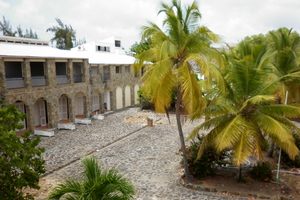Over time, the Caribbean has attracted many famous entrepreneurs with big dreams. In various cases, only intriguing ruins of these dreams remain. The Titchfield in Port Antonio, Jamaica, is the most famous example, after a shipwrecked Errol Flynn decided to take over Lorenzo Dow Baker’s prestigious resort. The hotel, thanks to Dow Baker’s banana boats, can be considered the origin of Caribbean tourism but was never rebuilt after a fire. All that remains is the Errol Flynn Marina, though promises from investors to rebuild his Navy Island part of the property have been buzzing for well over half a century.
St. Martin has its own “Titchfield” — but in way better shape. It cannot be reached by land, but a boat trip to explore its coast is well worth it, as, like its Jamaican counterpart, this once-flagship resort is a seaside property.
La Belle Creole has far more in common with Titchfield than just being a resort that did not make it through time. Neither Errol Flynn nor developer Claude Philippe of La Belle Creole was a hotelier. Having said that, “Mr. Waldorf” Philippe was better informed about the business as chef of New York’s most famous hotel. As was the case with Flynn, developer Philippe intended to charm Marilyn Monroe as a guest (though Flynn succeeded and Philippe did not, as his building project was to take decades and Monroe had passed away by then).
Both share the fact that neither had a full-fledged, picture-perfect Caribbean beach in front. At Titchfield, it is more like a grassy knoll ending in the sea. At La Belle Creole, a somewhat rocky cove was where guests were expected to bathe. This is probably the reason why this resort property has not been sold since its closure in 1995, as beach access has become a must in today’s resort development scene. The same might explain why the Titchfield was never rebuilt.
Both hotels also share the pattern that ever since the end of their famed careers, rumors of rebuilding have continued, as have takeovers of the respective properties — but nothing has happened.
A big difference, however, lies in why the hotels met their end. Flynn died in 1959 before realizing his ambitions with Titchfield, only nine years after its purchase. His envisioned glamour hotel burnt down a decade later. For Flynn, it can be said it was a high-society glamour show-off, building on famous previous clientele like Winston Churchill and J.P. Morgan.
For Philippe, ambitions were different. Being well acquainted with the demands of the New York upper class, he wanted to provide the most amazing hospitality experience in the world, in which every part of the experience had to be perfect. La Belle Creole (the beautiful Creole) was designed as a Mediterranean fishing village (including community buildings and a church-feel watchtower for sea views), built from the most expensive materials from all over the world. Violinists and other musicians were to play on corners to stylishly entertain guests while walking through “the village.”
It is these high demands — to make things worse, often changing throughout the building process — that made the project both endless and constantly short of funds.
It opened briefly in 1989, only to close in 1995 because of Hurricane Luis. By this short timeframe, tourism had already changed from an exclusive hobby of the wealthy to a pastime of the masses. It also meant Philippe had to adjust course and make concessions, with the resort, in its short lifespan, becoming a Hilton mass-brand property. It is said that the fine furniture of the resort can still be found in many island homes.
Nowadays, the village, the remnants of a bridge towards its peninsula, its rocky beach and viewing tower are all popular sights for visitors by catamaran, motorboat or private charters. It might not have been the way Philippe would have envisioned his attraction of visitors, but the legend remains.


